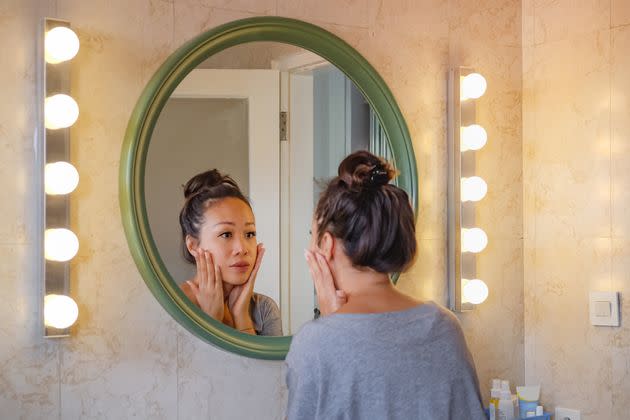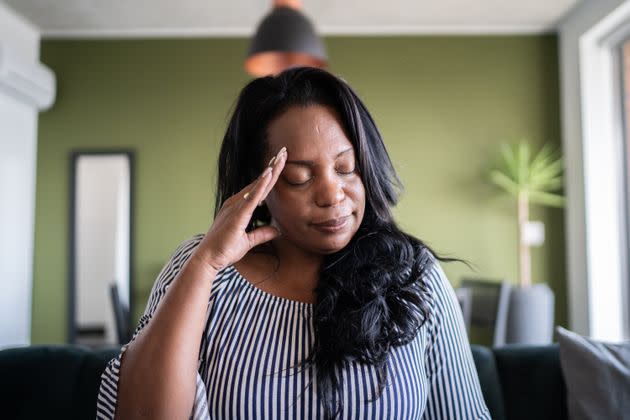Anxiety Can Cause Burning Or Tingling In Your Face. Here's What Helps.

Dealing with anxiety is more common than most people realize, but accepting how frequently it may happen is only the first step. Understanding what anxiety is and how it manifests, is crucial in the treatment and management of this mental illness.
One of the physical ways anxiety shows up? Facial burning or tingling.
Facial burning often feels like your skin or your face is hot, and also yields to redness. This occurs because of your body’s stress response, according to Shanya Hardie, a psychiatrist at MyPsychiatrist PLC in Virginia. Anxiety causes the brain to release chemicals into the body, which then prompt your blood vessels to spring into action.
“The surge of blood to the face as the vessels relax causes reddening or the sensation of heat,” Hardie explained.
The painful sensation tends to be concentrated around the cheek area, but it can also flush out to your whole face. The burning can last at least 15 minutes or until you’re able to abate extreme stress.
Anxiety affects different body mechanisms as your brain responds to situations or thoughts it perceives as threatening. Some common physical manifestations of this include an increased heart rate, gastrointestinal issues, muscle tension and shortness of breath. Facial redness is just another one of those physical manifestations.
If this sounds familiar, you’re certainly not the only one who experiences it. (You also shouldn’t ignore it; sometimes face tingling can be signs of a stroke, neuropathy or other health condition that deserves prompt medical care.) Here’s how to reduce facial burning when you have anxiety, according to experts:
Identify what triggers your anxiety.
“Anxiety can be triggered by a thought, a physical sensation, smells, certain people or situations,” said Jennifer Bronsnick, an anxiety treatment specialist based in New Jersey. “Anxiety can also come on without really understanding why because it can be triggered by an unconscious memory.” Everyone’s experience is unique.
To help you figure out what’s prompting your symptoms, start bygoing through a mental checklist of what may have prompted your facial burning. Could it be negative thinking, financial concerns, conflict, stress at work or a flashback to a traumatic event? What happened right before you started feeling your symptoms?
Keeping a record of past triggers can also help in the elimination process and aid you in identifying new triggers.
Distract your mind.
Experts also suggest shifting your focus to something different than the sensations you’re feeling. Try counting the number of objects in a room, smell a scent you enjoy or talk to a trusted friend about what you are feeling.
Purposeful, deep breathing can also physically calm your body down if you’re feeling stressed or anxious. Try a simple breathing technique like the 4-7-8 method, where you inhale through your nose for a count of four, then hold your breath for a count of seven. Then, release by exhaling through your mouth for a count of eight. Inhaling and exhaling increases oxygen to the brain and stimulates the parasympathetic nervous system that creates a feeling of calm.
Other ways to distract your mind can be listening to soothing music, cuddling pets, reading a book, playing a video game, coloring an adult coloring book or watching a mindless show.

Apply a cool cloth to your face.
While the burning sensation likely won’t stop completely until the anxiety is controlled, applying a cool cloth on your face can ease the discomfort.
Simply run cold water over a washcloth or towel, squeeze out excess water, fold and apply to your face. Making a cold compress by adding ice cubes to washcloth can also help, but make sure it’s not too cold, as that can cause other skin issues.
Stand in a cool shower.
Using the shower gives the same benefit of the application of a cool cloth, and may even help distract your brain from an anxiety or panic spiral. Research shows cold or cool showers can improve blood circulation, which may help bring blood pressure down if it’s high due to anxiety.
Talk to a therapist.
If you are struggling with physical symptoms of anxiety — like burning or tingling — that won’t go away, it might be time to reach out to a mental health professional. This is particularly important if it’s impacting your personal relationships or your ability to function in everyday life. Therapists can help you work through anxiety and give you coping resources for when it comes up in the moment.
If you have a history of experiencing anxiety and are just now experiencing facial burning, this may be a new manifestation. Just like all other medical issues, see a doctor to get an accurate diagnosis and treatment plan.
This article originally appeared on HuffPost and has been updated.

 Yahoo Movies
Yahoo Movies 


